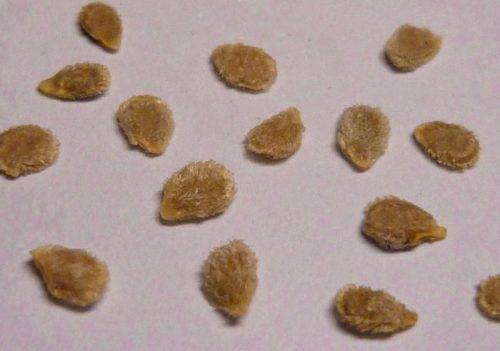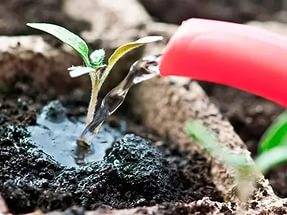Content
- 1 What you need to know about choosing seeds
- 2 What kind of soil is needed for tomato seedlings?
- 3 Preparing tomato grains for germination
- 4 How long does it take for a tomato seed to germinate?
- 5 Germination of tomato seeds
- 6 Choosing containers for tomato seedlings
- 7 Time to plant tomato seeds for seedlings
- 8 Sowing tomato seeds in the ground
- 9 Watering germinating seedlings
Sow tomato seeds You can use dry or germinated seedlings. Additionally, the grains are pickled, hardened, soaked in a growth stimulant, and some do without it. There are many sowing options. It’s easier, of course, to place the seeds straight from the packet into the soil and forget about them. However, in order to achieve good seedlings, before germinating tomato seedlings, it is better to subject the seed material to all stages of processing.
What you need to know about choosing seeds
To get a good harvest, tomato seeds must be selected correctly. To do this, several main factors are taken into account:
- Climb in indoor conditions will be all the grains, but it is necessary to take into account the region where future tomatoes are grown. For areas with cold climates, it is optimal to buy seeds of tomato varieties adapted to such conditions.
- Even before purchasing tomato seeds, you need to decide where to grow the crop. In the southern regions, it is customary to grow tomatoes in open ground, but in cold regions, the only place where the crop can grow can be a greenhouse.Most of the bred tomato varieties are universal, that is, they can grow in closed and open beds. But there are tomatoes designed for certain growing conditions. It is unacceptable to plant greenhouse varieties in the garden, and tomatoes intended for open ground in the greenhouse. This threatens to reduce yields, poor taste of fruits, and even death of plants.
- When choosing tomato seeds, you need to read on the packaging what type of bush is inherent in this variety. Tall bushes are called indeterminate. These tomatoes are better suited for greenhouses. Plants require more care associated with the formation of a bush, attaching stems to a trellis, etc. Medium- and low-growing tomatoes are called semi-determinate and determinate, respectively. Such crops require less care and are most often grown in open ground.
The remaining criteria for choosing seed material depend on the preferences of the vegetable grower. This takes into account the future size of the tomatoes, their purpose, shape, flesh color, and taste.
Amateur bags are small and usually contain up to 10 beans. Occasionally you can find a package with 15–20 seeds. Professional packaging is large. Inside there can be from 500 to 100 thousand tomato grains.
What kind of soil is needed for tomato seedlings?
You need to take care of the soil even before the tomato seeds begin to germinate. After all, sprouted grains must be sown immediately, otherwise the hatched embryos will die. The easiest way is to buy soil in a store. It already contains the entire complex of microelements.
When preparing the soil yourself, take soil from the garden as a basis, add peat and humus. If the soil is very dense, sawdust or river sand is also added to loosen it. Wood ash is used as soil fertilizing. Additional required feeding mineral fertilizers:
- a solution of potassium sulfate is prepared from 10 liters of water and 20 g of dry matter;
- the urea solution is diluted with water in a proportion of 10 g per 10 l;
- superphosphate solution consists of 10 liters of water and 30 g of dry fertilizer.
All components can usually be purchased at the same retail outlets where seeds are sold.
Preparing tomato grains for germination
There are many ways to prepare tomato seeds for germination. We will look at the simplest and most common:
- For disinfection of tomato seeds immerse for 24 hours in a container with a solution of 0.8% vinegar. Then soak for 20 minutes in a 1% manganese solution and wash with warm water.
- Immersing the seeds in hot water at a temperature of 60 will help to start the growth of the embryo.OFor half an hour.
- The next process involves soaking the tomato seeds. They are placed for 24 hours in warm water, temperature 25OWITH.
- The last stage consists of hardening. The tomato grains are scattered on a plate and placed in the refrigerator for a day. Some vegetable growers increase the hardening time to 48 hours, which is also allowed.
Each vegetable grower has a different attitude towards the process of preparing seeds. Some prefer to do without this and sow directly from the bag into the ground, others do not soak only the grains of hybrids.
How long does it take for a tomato seed to germinate?
Novice vegetable growers often have a question: “How quickly do tomato seeds germinate? How many days will it take for the seeds to hatch from the soil if they are not soaked?” and others... Indeed, such questions are important, since determining the time of sowing in the ground and obtaining ready-made seedlings depends on this.
How quickly a tomato grain will germinate depends on its storage conditions and age. When buying seeds, you need to pay attention to the production time. For example, you need to take the same variety of tomato. Grain collected 3 years ago will germinate in about 7 days, and last year’s seed can hatch in 4 days.
In order for tomato seedlings to grow to the required parameters by the time they are planted in a permanent place in the ground, you need to know how many days the first shoots should sprout. It should be noted right away that tomato seeds of any variety do not differ in germination time. It all depends on the sowing method. If the grains are placed in the soil immediately from the dry packet, the sprouts will sprout on the tenth day. A pre-soaked and hatched seed will sprout within 5 or 7 days.
The germination time depends on the depth of soil filling, which should not exceed 10–15 mm. It is important to maintain room temperature 18–20OC. Failure to comply with these parameters can significantly increase the germination time of tomatoes.
Germination of tomato seeds
So, let's say the tomato seeds have undergone preliminary preparation, and we begin to germinate them. For this process you will need cotton fabric or regular medical gauze. Moisten the cloth with warm water and spread it on a plate or any tray. Scatter the tomato grains on top in one layer and cover them with the same damp cloth.Next, the plate with tomato seeds is placed in a warm place with an air temperature of 25 to 30OC, and wait until they hatch.
However, a large amount of water is unacceptable. Floating tomato seeds will simply get wet.
Vegetable growers often stock up on melt or rain water to soak seeds. Growth stimulants added to the water help speed up the pipping process. These can be store-bought preparations or juice from the leaves of an aloe flower.
You need to know that tomato seeds hatch unevenly, and you need to keep an eye on them. By this time, the planting soil should be ready. The grains with the emerging embryos are immediately carefully sown, and the rest wait their turn until they hatch.
Choosing containers for tomato seedlings
There should be no problem choosing a container for sowing tomato seeds for seedlings. Specialized stores offer a huge number of plastic, peat and paper containers of various shapes. There are collapsible cups with a removable bottom and cassettes. Such products are inexpensive and affordable for any vegetable grower. As a last resort, you can take any disposable cups or make pots from PET bottles.
It is advisable to place drainage at the bottom of each glass. These can be small pebbles or crushed shells.
Time to plant tomato seeds for seedlings
Tomato seedlings that have reached 60 days of age at the time of planting are considered the strongest. The timing of sowing grains is determined individually, depending on the climatic conditions of the region. For example, in the middle zone, early tomatoes are sown for seedlings from mid to late February. Greenhouse varieties of tomatoes are sown in the first ten days of March. If tomatoes are intended for open growing, sowing seedlings is preferable by the end of March.
Sowing tomato seeds in the ground
You can sow tomatoes for seedlings in separate cups or in a common box. Each vegetable grower chooses a method that is convenient for him. But the process of sowing seeds in the ground is the same:
- A drainage layer is placed in the prepared container. Prepared soil 60 mm thick is poured on top. The soil is first compacted a little, watered, and then loosened.
- If tomato seedlings are grown in a box, it is necessary to make grooves in the soil with dimensions of approximately 15 mm. Grooves can be pressed out by running your finger across the ground. It is important to maintain a distance of about 50 mm between the grooves.
- If sowing grains is done in cups, make 3 holes 15 mm deep in the soil. In the future, the strongest tomato is selected from the three sprouted sprouts, and the remaining two are removed.
- The prepared depressions are moistened with water at a temperature of 50OWith or nutrient solution. The seeds are laid out along the grooves in increments of 30 mm. One tomato seed is placed in the holes in the soil of the cups.
- When all the seeds are placed in their place, the holes are filled with loose soil, after which they are slightly moistened with a sprayer. The soil with sown tomatoes is covered with a transparent film, and the containers themselves are placed in a warm place with a room temperature of 25OFrom before seedling germination.
The film is removed only after germination.During this period, the ambient temperature cannot be allowed to drop, plus care must be taken to ensure good lighting.
Watering germinating seedlings
The first watering after sowing grains in the ground is carried out on the tenth day. By this time, tomato sprouts will emerge from the soil en masse. They don’t need a lot of moisture, so pour a teaspoon of water under each plant.
The frequency of all subsequent waterings until the first full-fledged leaves grow on the plant is 6 days. The soil under the plants should be slightly moist. A large amount of water will lead to silting of the soil. This will cause the tomato root system to receive less oxygen and begin to rot. The last watering of seedlings is carried out 2 days before picking. At the same time, you can feed the tomatoes with mineral fertilizers.
The video shows the entire process of growing tomato seedlings from germination to picking:
That’s basically all the secrets of germinating tomato seeds for seedlings. Next, before planting the plants in the ground, there is still a lot of work to be done. This includes picking, fertilizing, plus adult seedlings need to be hardened off. But for these efforts, the culture will thank the gardener with delicious tomato fruits.
















